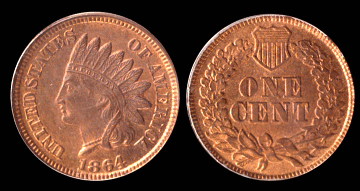The Indian Head penny circulated from 1859 to 1909--longer than any US coin, I believe, until the Lincoln cent surpassed it. I think these pennies could buy as much as a dime or a quarter now, so people wouldn't have spurned them. The pennies circulated during the Indian Wars, when many of the worst slaughters in Indian country occurred. I suspect they influenced how Americans perceived Indians.
Here's the story behind the coin:
This 19th Century Cent Design Lasted For Only One Year
When a number of people questioned the use of the Indian, mint engravers explained this was a North American Indian girl. This idea continued to be popular into the 20th Century. However, the Indian on the gold coins of Pratt and Saint-Gaudens and James E. Fraser’s so-called “Buffalo” (really a bison) or Indian five-cent coin, depicted real Indians rather than a girl wearing an Indian headdress.
Mint Director Snowden was very impressed with the new “Indian Head” obverse for the one-cent piece. He wrote, “The obverse, it will be seen, presents an ideal of America--the sweeping plumes of the North American Indian giving it the character of North America.”
Cornelius Vermeule, in his fine book: “Numismatic Art in America,” commented that Longacre’s depiction “with the flowing hair and a few cascading feathers and a necklace” seemed more natural. According to Vermeule, “the coin became perhaps the most beloved and typically American of any piece great or small in the American series.”
I suspect most people thought it was a genuine Indian girl. Why? Because it was an Indian Head penny, not a Liberty Head or White Girl Head penny. Because people didn't think of Liberty as a young girl. Because the mint tried to fudge the issue with its references to Indians. And because the penny matched the stereotypical impression of what an Indian looked like.
Initially, people didn't like the idea of having a "savage" Indian on one of their coins. But choosing a sanitized Caucasian girl with Greek features to represent an Indian made it okay. They grew to love their cherubic "Indian" girl, so safe and sane was she. She was one of the good Indians who wouldn't hurt a fly--not like those bad Indians who were killing settlers. She was an early version of an Indian mascot--a favorite pet, just like a real little girl.
Of course, few people realized that a real Indian girl wouldn't be caught dead wearing a chief's headdress. The "plumage" was reserved for revered male leaders and warriors. But the mint's people either didn't know that or didn't care.
Whomever the penny depicted--Liberty or an Indian girl or a white girl playing an Indian--it symbolized something. I like the mint director's claim that the Indian wannabe represented the "ideal" or "character" of America. Yes, she sure did. Some quotes from The Political Uses of Stereotyping help make the point:
Playing Indian was a way for the interlopers to transform themselves into authentic Americans. As Deloria observes, "Conflating Indians and land, the rioters suggested that these qualities lay embedded in the American soil itself and that, as the environment reshaped settlers' personalities, freedom and liberty had made their way into the psychic makeup of white Europeans." [Philip J. Deloria, Playing Indian]
"Indians had been slaughtered; for the sake of the new race of Americans, they must be resurrected and commemorated, their 'pure' image preserved in gold," Trachtenberg writes. ... "Freezing the Indian image as 'pure' so that it could be incorporated as an ingredient in American whiteness was a cure to both blackness and the 'inferior' strains from Eastern and Southern Europe," he writes. ["What It Means to Be an Indian in America," Hartford Courant]
For more on the subject, see America's Cultural Roots.


1 comment:
Interesting take on it.
Post a Comment